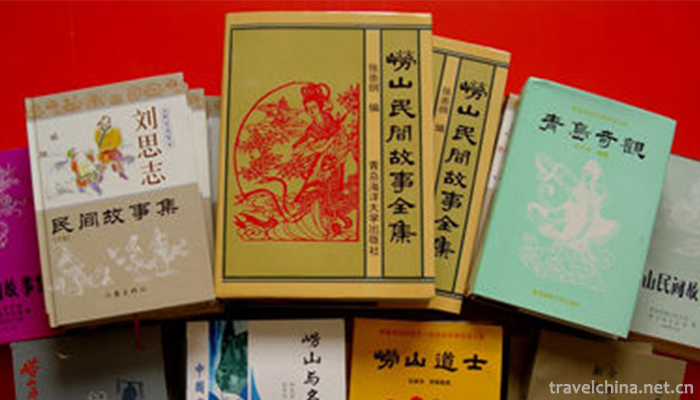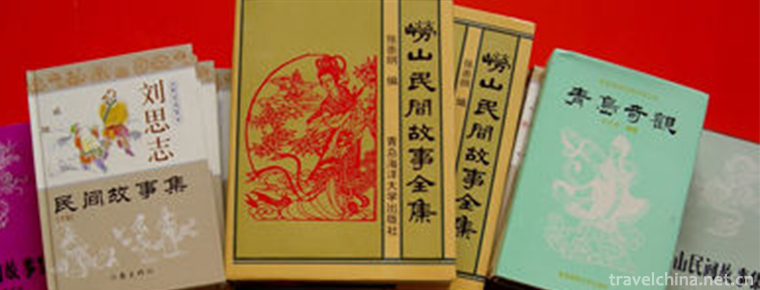Laoshan Folk Stories
Laoshan Folk Stories
Laoshan folk tales, commonly known as Lagua, are oral literature created by the local people of Laoshan Mountain in Shandong Province for thousands of years. There were few written records before liberation.
On June 7, 2008, Laoshan folk tales were listed in the second batch of national intangible cultural heritage list with the approval of the State Council.
Historical origin
Laoshan folktales have a wide range of categories, a large number and rich content. From the collected content of Laoshan folktales, it can be inferred that Laoshan folktales first occurred in ancient times. According to the biography of Pu Songling in Shandong Province, in April of the eleventh year of Kangxi (1672), Pu Songling, 32, traveled to Laoshan with the local gentry Gao Hu and Tang Menglai. Inspired by the folklore stories of Laoshan at that time, he wrote short stories Xiangyu and Laoshan Taoists on the theme of enduring winter, peony and Laoshan Taoists, which were also the earliest writings of Laoshan folk stories.
primary coverage
The contents of Laoshan folktales include "myths", "legends", "stories" and so on, covering more than 5600 natural change myths, heroic myths, historical legends, religious legends, fairy tales, mountain and river legends, specialty legends, ghost and fox ghost stories, animal stories, life stories, wit character stories, etc. Influenced by nature, geographical environment and Taoist culture, among the local folktales in Laoshan, the most numerous and distinctive ones are the legends of local customs, religious figures, ghosts and foxes, ghosts and ghosts, and sea stories.
Inheritance significance
Laoshan folk tales are characterized by the convergence of local popular culture and mountain and sea culture, and evolve in the mutual penetration of secular culture and religious culture, with distinct regional characteristics. It has high historical and literary value.


-
1.barbecued porkTime 2018-11-02
-
2.Xibaipo Scenic Area Pingshan County Shijiazhuang
Xibaipo is located in the middle of Pingshan County, Shijiazhuang City, Hebei Province, with a total area of 16,440 square meters. It was the seat of the CPC Central Committee
Time 2018-11-24 -
3.Dunhua Liudingshan Cultural Tourist Area
Dunhua Liudingshan Cultural Tourist Area is located in the South Bank of Mudanjiang River, 3 kilometers south suburb of Dunhua City
Time 2018-12-05 -
4.Wuxi film and television base
The Wuxi Film and Television Base of CCTV was originally built by CCTV to shoot "Tang Ming Huang", "Romance of the Three Kingdoms" and "Water Margin"
Time 2018-12-06 -
5.Heilongjiang Science and Technology Museum
Heilongjiang Science and Technology Museum is located in Sun Island Science and Technology Park of Harbin City, which is a ship-shaped building sailing
Time 2018-12-08 -
6.Linhe Yellow River National Wetland Park Inner Mongolia
Inner Mongolia Linhe Yellow River National Wetland Park is located in Linhe District, Bayannaoer City, Inner Mongolia Autonomous Region, with a total area of 4637.6 hectares. The functional zoning map
Time 2018-12-26 -
7.Guyuan Northern Dynasty Sui and Tang Dynasties Cemetery
The tombs of the Northern Dynasty and Sui and Tang Dynasties in Guyuan are located in Xiaomazhuang, Yangfang, Shengou, Dabao, Wanglioba, five natural villages in the West and south suburbs of Yuanzhou
Time 2019-01-12 -
8.Taishan Hot Spring City
Taishan Hot Spring City Cultural Tourism Scenic Spot is invested and constructed by Shandong Taishan Hot Spring Tourism Development Co., Ltd. with a total investment of 2.6 billion yuan
Time 2019-02-13 -
9.Bouyei costume Guizhou Province
As a material and cultural phenomenon, the production and change of Buyi costumes are always in line with the social and economic development.
Time 2019-04-04 -
10.Exhibit of lanterns
The Lantern Festival is an ancient folk culture in China. It generally refers to the large-scale lighting exhibition held by the government around the Spring Festival and the Lantern Festival
Time 2019-04-26 -
11.folk song of northern shaanxi
Northern Shaanxi folk song is a traditional folk song in northern Shaanxi, which can be divided into three categories: labor chant, Xintianyou and minor. Labor chants include tamping song, blockbuster
Time 2019-06-13 -
12.Inkstone making skills
Inkstone making skills, local traditional handmade inkstone making skills in Shexian County of Anhui Province and Wuyuan County of Jiangxi Province, is one of the national intangible cultural heritage
Time 2019-07-01